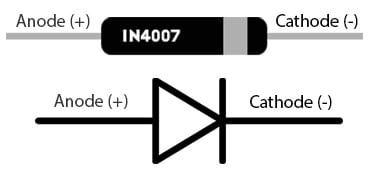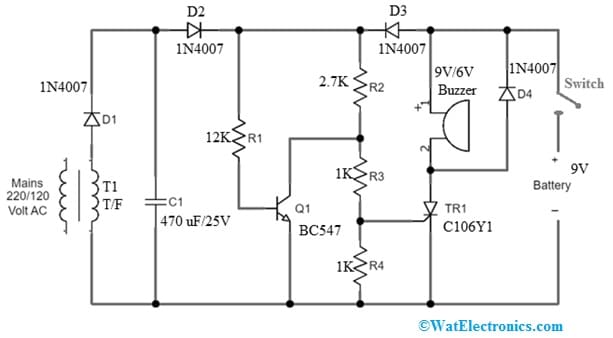A diode is a two-terminal semiconductor device that works as a one-way switch mainly for current within a circuit. The diode allows the flow of current easily within a single direction and restricts the flow of current severely from supplying in the other direction. This can be called a uni-direction device and it can be used as a rectifier within the electronic circuit. Generally, the diode works in a forward-bias condition whereas in a reverse-bias condition, current does not supply throughout this component. There are different kinds of diodes available based on different structures which are used in different electronic applications. In this article, we are going to provide brief information on a 1N4007 diode, pinout, specifications & its applications.
What is 1N4007 Diode?
The 1N4007 diode is a general-purpose 1N400x series diode that is used as a rectifier within power supply circuits for changing AC to DC. The maximum current that can flow throughout this diode is 1 Amp and it has a very low reverse current like 5uA. This diode is used wherever high voltage is used & can handle almost 1000 volts. These types of diodes are compact and suitable for space-constrained applications.
Pin Configuration:
The pin configuration of the 1N4007 Diode with its symbol is shown below. This diode includes two terminals which are discussed below.

1N4007 Diode Pin Configuration
- Pin-1 (Anode): The current always enters throughout this terminal.
- Pin-2 (Cathode): The current exit is always throughout this terminal.
1N4007 Diode Working
Whenever the voltage supply at the anode terminal exceeds the voltage supply at the cathode terminal, then this diode is known as forward-biased. In this condition, the maximum amount of current supply that the diode can conduct is 1 ampere stably. Theoretically, whenever the voltage at the cathode terminal exceeds the voltage supply at the anode terminal, then this diode will not conduct current. If the voltage difference becomes large sufficient, then the flow of current throughout this diode will enhance & the diode will stop working.
Features & Specifications:
The features and specifications of the 1N4007 Diode include the following.
- It is a rectifier diode with two terminals.
- Its average forward current is 1A.
- Its low power dissipation is 3W.
- Its max RMS voltage is 700V.
- Its junction capacitance typically is 15pF.
- Its reverse recovery time typically is 2.0us
- The type of mounting is Through Hole.
- It has a low forward voltage drop.
- It has the capability of a high forward surge current.
- It has low leakage & reverse current
- It is RoHS-compliant & Pb-free.
- It is available in the DO-41 package.
- Its repetitive reverse voltage maximum is 1000 V.
- Its forward voltage is 1.1 Volts.
- Its average forward current is 1A.
- Its maximum non-repetitive forward current is 30 A.
- Its reverse current is 5 uA
- Its maximum storage and operating temperature ranges from -55 to +175 Centigrade.
Check the list of points that need to be considered before choosing a diode.
Replacement & Equivalents
1N4004 diode is used if you are working below 400V, 1N4005 diode is used if you are working below 600V and 1N4006 diode is used if you use 800V is used because 1N4007 diodes are accurately the same in other values.
If you are working > 800V and < 1000V then you can use HER158, HER208, FR107 & FR207 Diodes are used as equivalents. Similarly, if you are working > 1000V then EM51, 1N5399 & EM520 diodes are used as replacements.
How to use 1N4007 Diode safely in a Circuit for a Long Time?
To use the 1N4007 diode very safely in a circuit for a long time it is suggested to stay 30V – 40V under from its maximum repetitive reverse voltage. Do not drive any load above 1A and connect the terminals properly in a circuit. Do not store & operate this transistor in temperature range <-55 degrees centigrade & > +175 degrees centigrade. While using a diode it is important to select a right value of resistance. Read on How to select the base resistance of a Diode ?
Alarm Circuit for Power Interruption with 1N4007 Diode
Making an alarm circuit for power interruption is a great method to track power outages continuously in your office or home. This power interruption alarm circuit informs a person through an alarm when a power interruption occurs.
The required components to make this alarm circuit for power interruption mainly include; mains 220/120 Volt A/C, 470 uF/25V polar capacitor, TR1 C106Y1 thyristor, resistors R1-12K, R2 -2.7K, R3 and R4 – 1K, diodes D1 to D4 1N4007, 9V battery, BC547 transistor and 9V/6V buzzer. Connect the circuit as per the following diagram shown below.

Alarm Circuit for Power Interruption with 1N4007 Diode
Working
This power interruption alarm circuit is simply connected to the main power throughout the T1 transformer, which increases the AC voltage. This voltage can be rectified through the D1 diode after that, it is filtered through the C1 capacitor. This alarm circuit works through a Q1 transistor & a TR1 thyristor. Whenever the mains voltage is there, the Q1 transistor maintains a small amount of voltage at the gate terminal of the thyristor and it avoids getting triggered & generating an alarm.
The thyristor in this circuit is connected simply to a 9V battery. When a power failure occurs, then the voltage from the 220/120 transformer will disappear & the Q1 transistor will turn off. So this simply allows the 9V battery to D3 forward bias diode and the voltage at the thyristo’s gate terminal enhances, triggering it & generating the alarm throughout the connected buzzer.
If the power supply returns, then an error message will not end because, the thyristor will stay latched in its activated condition, although now the thyristor’s gate terminal is at zero voltage. To disable the alarm & also to reset this circuit, it is essential to turn off the battery supply temporarily through a switch that can be coupled in series through the battery (or) the TR1 thyristor.
Advantages and Disadvantages
The advantages of the 1N4007 diode include the following.
- It has a high surge current capacity.
- It has a high-temperature operation.
- It is not expensive.
- It has a low forward voltage drop.
- It has the capability of a high forward surge current.
- It has low leakage & reverse current
- It is RoHS-compliant & Pb-free.
The disadvantages of the 1N4007 diode include the following.
- It has limited reverse voltage ability.
- It has a low breakover current.
- It has low power dissipation.
- This diode has a reverse leakage current.
Applications
The applications of the 1N4007 diode include the following.
- 1N4007 rectifier diode is normally designed to change AC to DC in power supply circuits of electronic devices.
- These are used for the rectification of power supplies, converters, inverters & freewheeling diodes-based applications.
- These diodes are frequently used in protection circuits, regulator circuits & rectifier circuits.
- This diode can also be used where there is a requirement of blocking voltage, voltage spikes blocking, etc.
- This diode is applicable in digital logic circuits.
- These diodes are used in adapters, battery chargers, power supplies, voltage doublers, protection of components, etc.
- These are used in voltage regulation, as a protection diode, flyback diode, voltage clamping, etc.
- These are used in half-wave rectifiers and full-wave rectifiers.
- These rectifier diodes are used in battery charging & discharging circuits.
- These are used in signal demodulation, motor control, voltage multipliers, switching circuits, lighting control, DC to DC converters and to protect within automotive circuits.
Please refer to this link for the 1N4007 Diode Datasheet.
Thus, this is an overview of the 1N4007 Diode, pin configuration, features, specifications, circuit, working, and its applications. The 1N4007 is a very popular general-purpose 1A silicon rectifier diode and it has a diffused PN junction. This diode has 5 uA of low reverse leakage current and this diode is mainly designed for operating with higher voltages & it can withstand voltages easily <1000V. This rectifier diode is an ideal diode to use in different applications because of 1A of average direct current, 3W power dissipation, low cost & its small size. Here is a question for you, what is 1N4003 Diode?